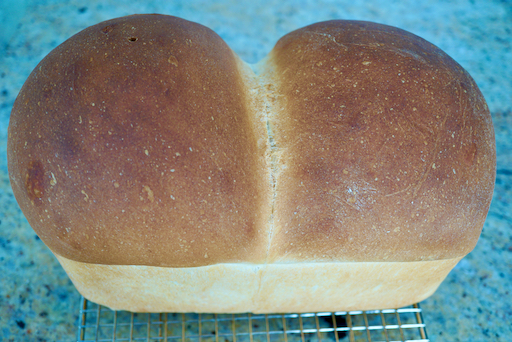This is an addition to the on-going saga of my wife making Japanese-style milk bread. As a gift, we received several large hard cover cookbooks; one was the “French Laundry Cookbook” and another was “Bouchon Bakery”. While browsing through the books my wife found a recipe called “Pain-au-Lait Pullman loaf”. Since she can read French fairly well, she immediately recognized this translated to “milk bread”. As she read the recipe, she found out it was indeed a Japanese style milk bread but they replaced the milk with cream cheese to make the crumb more moist. Although she thought she had already baked a full gambit of Japanese milk breads, she determined this was a variation she had not yet attempted and, besides, cream cheese is one of her favorite ingredients. So she went for it. The instructions were a bit unusual (read: incomprehensible. For example at one point it says, and this is a direct quote, “mix on low speed for 4 minutes. Continue to mix on low speed for 30 minutes” (huh??) Would that be 34 minutes of continuous mixing ?!!) So she consulted me and we decided to follow our CCK (Common Culinary Knowledge). In addition since we do not have “Pullman” bread pans, we made the bread using a regular loaf pan. It came out quite well as seen below. This is a close tie with the original milk bread I made. But a slightly different flavor due to the cream cheese. Lightly toasted with butter...perfect for breakfast with a cup of Cappuccino or Cafe latte.
Ingredients:
547 g. AP flour
1 3/4 tsp yeast
32 g. sugar
11 g. salt
285 g. water
35 g. egg (probably one small egg)
25 g. butter (cut into cubes)
79 g. cream cheese (cut into cubes)
Recipe doubled:
1094 g. AP flour
3 1/2 tsp yeast
64 g. sugar
2 tsp. salt
570 g. water (or milk)
2 eggs
50 g. butter (cut into cubes)
158 g. cream cheese (cut into cubes)
Put the dry ingredients in the bowl of a stand mixer with a dough hook. Mix the water and the eggs together. Slowly add the mixture to the dry ingredients until incorporated. Add the butter and cream cheese. Continue mixing until it is incorporated. Add additional flour as necessary to achieve a smooth dough. Continue kneading for 7 to 10 minutes. Put in a bowl. Coat with vegetable oil cover and put into a proofing box set at 81 degrees until doubled in size. Deflate the dough. Form into two balls and put touching together into a heavily greased loaf pan. Return to the proofing box and let rise until slightly higher than the rim of the loaf pan. Bake in a 375 degree oven for 25 to 30 minutes or until it sounds hollow when tapped. We also made this bread as a muffin (3 oz. in large pyrex). While the muffin is good we think it is better as a loaf of bread.
This was one of the best milk breads my wife made. The texture was very soft but moist. It had a nice rich flavor and although I couldn’t taste it, my wife claimed she could taste a hint of the cream cheese which made it different from the previous variations she made. Toasted with butter...as I said perfect!






















